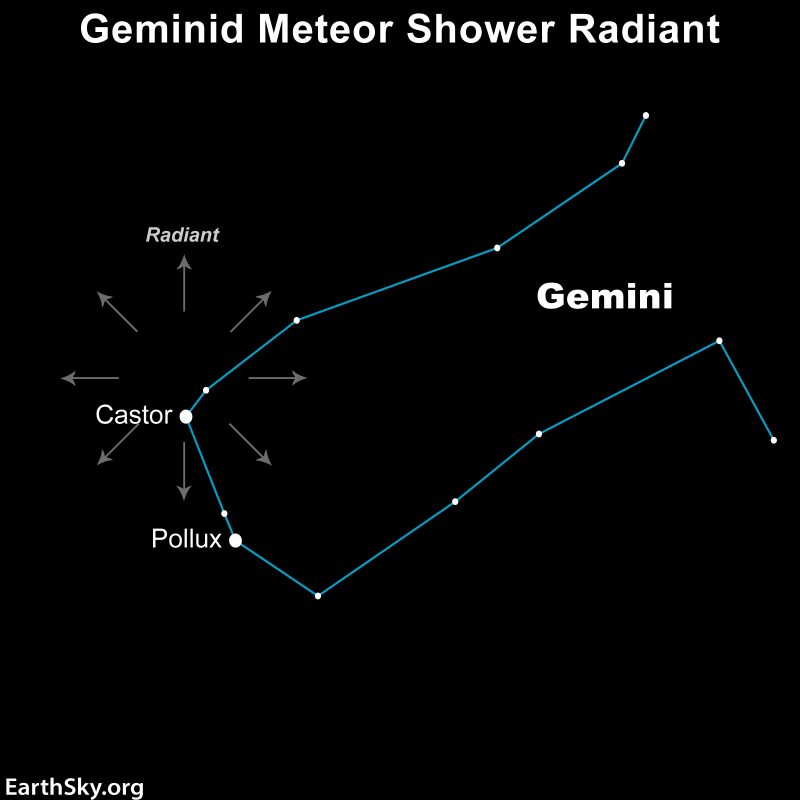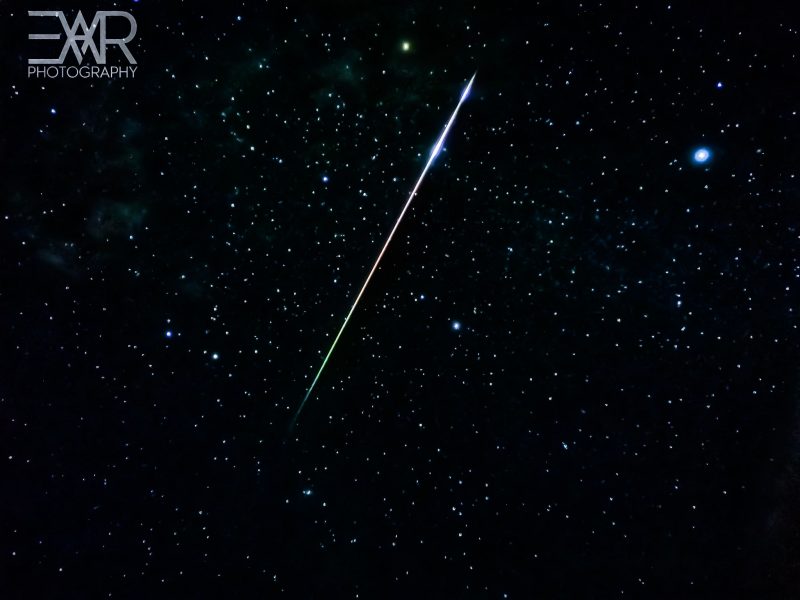
10 tips for watching the Geminids
2023’s Geminid meteor shower is expected to peak on December 14. This year, a thin waxing crescent moon won’t interfere viewing the meteors. And, the radiant point rises in mid-evening. So there will be darkness – on both the evenings of December 13 and 14 – from mid-evening until dawn. Read more about this year’s Geminid meteor shower.
Moon or no moon, the Geminid meteor shower is always worth a look. You never know when you’ll be surprised by a bright fireball. The radiant, which is near the star Castor in Gemini the Twins, rises in mid-evening for all of us around the globe. And then, it reaches nearly overhead around 2 a.m. (that’s why the shower is best then).
While it’s possible to see up to 120 meteors per hour on a dark night, when the radiant is overhead, it’s still exciting to see even just a handful of Geminid meteors. For your best chance to see the most Geminids, make sure you’re in a dark-sky location. Here are 10 tips to get the most out of the Geminids in 2023.
The 2024 lunar calendars are here! Best Christmas gifts in the universe! Check ’em out here.
1. The peak viewing time is around 2 a.m.
Geminid meteor numbers tend to intensify as evening deepens into late night, with the greatest number of Geminids likely falling an hour or two after midnight, when the meteor shower’s radiant point appears highest in the sky as seen from around the globe. That time holds true no matter your time zone. The waxing crescent moon will set soon after sunset on both December 13 and 14. So, you’ll be able to watch the Geminids in a moonless sky. Visit Sunrise Sunset Calendars to find the moonrise and moonset time for your specific location. Be sure to check the moonrise and moonset box.
2. Get away from city lights.
For optimum viewing, find a dark place to observe in the country.
3. Give yourself a wide-open view of the sky.
A farmer’s field? A stretch of country road? A campsite with a clear view in one or more directions? An open sky will increase your chances of seeing some meteors.
4. Watch for Geminids for an hour or more.
The 2023 Geminid meteor shower will be better if you let your eyes adapt to the dark. That can take as long as 20 minutes. Plus, the meteors tend to come in spurts, followed by lulls. Be patient! You’ll see some.
5. You don’t need to find the radiant point.
You don’t need to look in a single direction – or locate the Geminid’s radiant point – to have fun watching the shower. The meteors will appear all over the sky. The radiant point is interesting, though. If you track Geminid meteors backward on the sky’s dome, you’ll find them streaming from this point, within the constellation Gemini the Twins. Hence this shower’s name.

6. Pay attention to the moon.
The moon will be in a waxing crescent phase, the moon will not interfere with the Geminid meteors. However, if the moon was out – because you can look in any direction to spot Geminids – you can look at areas of the sky away from the moon. That’s because anything in the moon’s vicinity will likely be washed out by its bright light. Another tip for watching in moonlight: place yourself in a moon shadow. Observing from the shadow of a barn, or mountain, even a tree, can help you see more meteors.
7. Think about the Geminids’ parent object.
Most meteors in annual showers originate in comets. But the parent of the Geminid meteor shower is a mysterious body named 3200 Phaethon. This solar system object is termed an Apollo (near-Earth) asteroid, and it might be a dormant comet. This tidbit may not help you watch the shower, but it’s fun to discuss as you wait for the next meteor. Click here for more on weirdly comet-like 3200 Phaethon.
8. Bring along a buddy.
Both of you watch different parts of the sky. If you see one, shout “Meteor!” Let your eyes rove casually in all parts of the sky.
9. No special equipment needed.
You may be more comfortable with a reclining lawn chair, blankets, snacks and a hot drink. And leave your electronic devices in your pocket or the car. Even night mode is bright enough to ruin your night vision.
10. Enjoy nature.
As a wise man once said, meteor watching is a lot like fishing. You go outside. You hope you catch some!

Bottom line: The Geminids make up a rich and much-loved annual meteor shower that peaks in mid-December. Maximize your viewing time with these tips.











